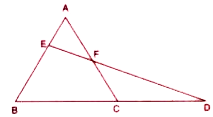In triangle ABC, side AC is greater than side AB. If the internal bisector of angle A meets the opposite side at point D, prove that : ∠ADC is greater than ∠ADB.
To prove that in triangle ABC, where side AC is greater than side AB, the internal bisector of angle A (AD) creates angles such that angle ADC is greater than angle ADB, we can follow these steps:
1. Identify the Given Information:
- We have triangle ABC.
- AC > AB.
- AD is the internal bisector of angle A, meeting side BC at point D.
2. Label the Angles:
- Let angle ADB = angle 1.
- Let angle ADC = angle 2.
- Let angle B = angle ABC.
- Let angle C = angle ACB.
3. Use the Angle Sum Property:
- In triangle ADB, the sum of angles gives us:
angle 1+angle B=angle ADB
- In triangle ADC, we have:
angle 2+angle C=angle ADC
4. Set Up the Equations:
- From triangle ADB:
angle ADB=angle 1+angle B(1)
- From triangle ADC:
angle ADC=angle 2+angle C(2)
5. Use the Angle Bisector Property:
- Since AD is the angle bisector, we know:
angle 1=angle 2
6. Substitute and Compare:
- Substitute angle 2 for angle 1 in equation (1):
angle ADB=angle 2+angle B(3)
- Now we have:
- From (2): angle ADC=angle 2+angle C
- From (3): angle ADB=angle 2+angle B
7. Establish the Inequality:
- Since AC > AB, by the property of triangles, we know:
angle B>angle C
- Therefore, we can write:
angle 2+angle C<angle 2+angle B
- This implies:
angle ADC<angle ADB
8. Conclusion:
- Thus, we have shown that:
angle ADC>angle ADB
- Hence, we have proved that angle ADC is greater than angle ADB.
- We have triangle ABC.
- AC > AB.
- AD is the internal bisector of angle A, meeting side BC at point D.
- Let angle ADB = angle 1.
- Let angle ADC = angle 2.
- Let angle B = angle ABC.
- Let angle C = angle ACB.
- In triangle ADB, the sum of angles gives us:
angle 1+angle B=angle ADB
- In triangle ADC, we have:
angle 2+angle C=angle ADC
- From triangle ADB:
angle ADB=angle 1+angle B(1)
- From triangle ADC:
angle ADC=angle 2+angle C(2)
- Since AD is the angle bisector, we know:
angle 1=angle 2
- Substitute angle 2 for angle 1 in equation (1):
angle ADB=angle 2+angle B(3)
- Now we have:
- From (2): angle ADC=angle 2+angle C
- From (3): angle ADB=angle 2+angle B
- Since AC > AB, by the property of triangles, we know:
angle B>angle C
- Therefore, we can write:
angle 2+angle C<angle 2+angle B
- This implies:
angle ADC<angle ADB
- Thus, we have shown that:
angle ADC>angle ADB
- Hence, we have proved that angle ADC is greater than angle ADB.
Topper's Solved these Questions
Similar Questions
If the bisector of an angle of a triangle bisects the opposite side, prove that the triangle is isosceles.
View SolutionIn ΔABC, angle ABC is equal to twice the angle ACB, and bisector of angle ABC meets the opposite side at point P. Show that :
CB:BA=CP:PA
View SolutionIn ΔABC, angle ABC is equal to twice the angle ACB, and bisector of angle ABC meets the opposite side at point P. Show that :
AB×BC=BP×CA
View SolutionIn a triangle ABC , AB = AC and ∠A=36∘ If the internal bisector of angle C meets AB at D . Prove that AD = BC.
View SolutionIn a △ABC the sides BC=5,CA=4 and AB=3. If A(0,0) and the internal bisector of angle A meets BC in D (127,127) then incenter of △ABC is
View SolutionIn a triangle ABC, side AC is greater than side AB and point D lies on side BC such that AD bisects angle BAC. Show that:
∠ADB is acute.
View SolutionLet triangle ABC be an isosceles with AB=AC. Suppose that the angle bisector of its angle B meets the side AC at a point D and that BC=BD+AD. Measure of the angle A in degrees, is :
View SolutionIn the given figure, AB = AC. Prove that AF is greater than AE.

View SolutionABC is a right triangle with AB = AC.If bisector of ∠A meet BC at D then prove that BC =2 AD .
View SolutionThe given figure shows a triangle ABC in which AD bisects angle BAC. EG is perpendicular bisector of side AB which intersects AD at point F.
Prove that : F is equidistant from AB and AC.
View Solution